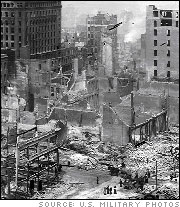San Francisco Earthquake: 1906

The worst natural disaster in U.S. history
by Chris Frantz
 San Francisco, California, April 1906 Related Links |
At 5:12 a.m. on April 18, 1906, the people of San Francisco were awakened by an earthquake that would devastate the city. The main temblor, having a 7.7–7.9 magnitude, lasted about one minute and was the result of the rupturing of the northernmost 296 miles of the 800-mile San Andreas fault. But when calculating destruction, the earthquake took second place to the great fire that followed. The fire, lasting four days, most likely started with broken gas lines (and, in some cases, was helped along by people hoping to collect insurance for their property—they were covered for fire, but not earthquake, damage). With water mains broken, fighting the fires was almost impossible, and about 500 city blocks were destroyed. The damages were estimated at about $400,000,000 in 1906 dollars, which would translate to about $8.2 billion today.
Uncertain Death Toll
In 1906 San Francisco was the ninth largest U.S. city with a population of 400,000, and over 225,000 were left homeless by the disaster. The death toll is uncertain. City officials estimated the casualties at 700 but more modern calculations say about 3,000 lost their lives. The lowballing city figures may have been a public relations ploy to downplay the disaster with an eye on rebuilding the city. On April 20, the U.S.S. Chicago rescued 20,000 victims, one of the largest sea evacuations in history, rivaling Dunkirk in World War II. Martial law was not declared, but some 500 looters were shot by police and the military.
Shifting Seismologic Knowledge
The epicenter of this earthquake has moved around in the past 100 years, as advances in seismology have been made. It was first thought to have been in Marin County, then northwest of the Golden Gate, and most recently, in the Pacific Ocean about two miles west of San Francisco. The plate-tectonics theory that would shed some light on the quake wasn't formulated until the 1920s and not embraced until some three decades later. The San Andreas fault is on the boundary between the Pacific plate and the North American plate. During the earthquake, the ground west of the fault tended to move northward and, in the most extreme instance, a 21-foot shift was measured. Earthquake ruptures are fast movers—seismologists estimated the average speed of this rupture to have been 8,300 mi/hr going north, and 6,300 mi/hr traveling south. The quake was felt from southern Oregon to south of Los Angeles and inland as far as central Nevada.
Magnitude
Charles Richter developed his scale in 1935 to measure the amount of seismic energy released, the magnitude, of an earthquake. Seismologists found the Richter scale fine for lower magnitude quakes, but inaccurate for higher magnitude ones. The 1906 earthquake was assigned a Richter rating of 8.3, but on the newer moment magnitude scale it has been demoted to one measuring 7.8 or 7.9.
"The Big One"
On Oct. 17, 1989, at 5:04 p.m., at the height of the rush hour, Bay Area residents thought the "big one" had struck. The 7.1 Richter scale (6.9 moment magnitude) Loma Prieta earthquake, with its epicenter about 60 miles from San Francisco, was the largest one to hit the region since 1906. Sixty to 70 deaths were reported, freeways and bridges were damaged, and the World Series between the Oakland and San Francisco teams was postponed for 10 days. Property damage was estimated at $6 billion dollars, making this the costliest natural disaster to that date. But seismologists said this was not the major earthquake feared by all. That one is still in the future.
In 1906 there were only about 650,000 people living in the area, but today more than 7 million people make their homes in the San Francisco Bay region. Scientists in 2003 estimated that there is a 62% probability of a 6.7 magnitude or larger earthquake hitting the Bay Area in the next 30 years and Californians live in the shadow of "the big one."
- More on Major Disasters
